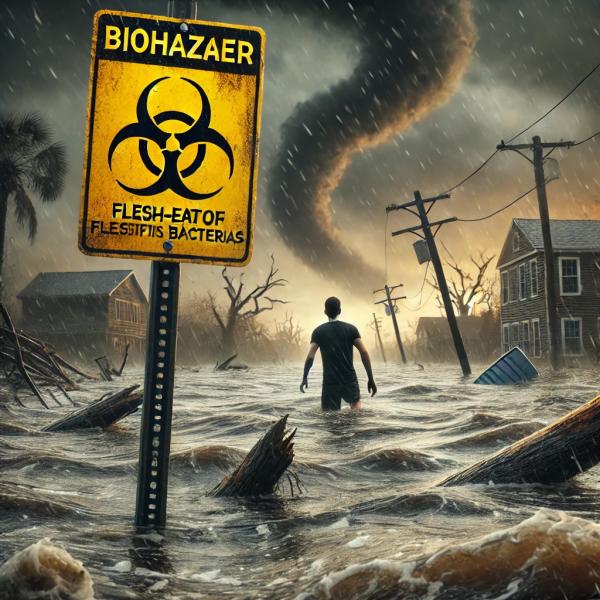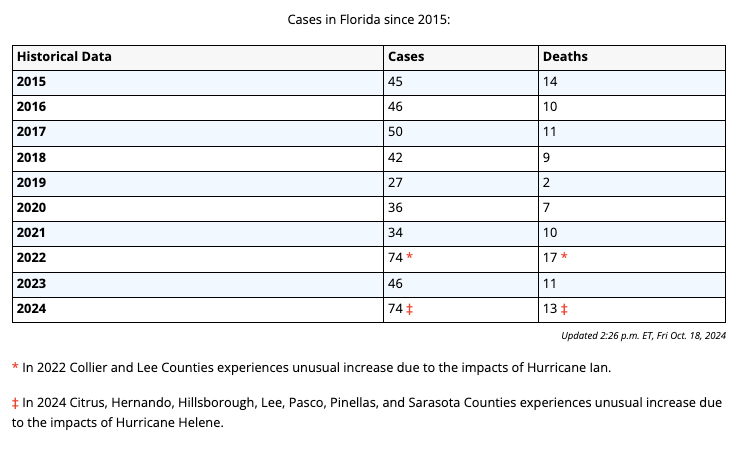
In the wake of Hurricane Helene, in addition to the loss of life and property damage, the Internet is reporting a sudden rise in flesh-eating bacterial infections.
“Flesh-eating bacteria cases rise to record level after hurricanes in Florida”
– USA Today
“Flesh-eating bacteria cases on the rise, at near-record level after Hurricane Milton in Florida”
– Naples Daily News
So, in the words often attributed to Rahm Emmanuel that one “should not let a good crisis go to waste,” let’s talk about what is really going on.
Per Florida Health, the state's official website, there has been an increase in infections due to a bacteria known as Vibrio vulnificus.

You can easily see the surge in 2022 and now, both related to hurricanes and the subsequent influx of seawater onto the land. Vibrio vulnificus is normally found in seawater, especially the Gulf's warm waters this time of year, so it is no surprise that there is a surge in cases and deaths. Of course, those oh-so-objective appearing numbers may not be what they seem.
Vibrio vulnificus infections may come from eating undercooked seafood or open wounds exposed to seawater in the case of immunocompromised individuals. As JAMA Network reports, these infections are extremely rare – about 100 are reported across the US annually. Food-related cases are often mild enough that they do not rise to the need for medical attention or are easily treated without a culture being taken. As a result, cases are probably under-reported. On the other hand, deaths due to the bacteria will have a positive culture, making the absolute number correct. However, the mortality rate, deaths divided by cases, is overinflated by the under-reporting of cases. What is fair to say is that individuals hospitalized with Vibrio vulnificus can be very ill and succumb to the infection at rates anywhere from 25 to 33% or more. To give context, deaths from sepsis, overwhelming infection, range anywhere from 6 to 34%.
Vibrio vulnificus multiplies rapidly in the blood, presenting often with some GI symptoms, a fever, and perhaps some limb pain. The rapidity of the infectious onslaught in the face of what appears to be mild symptoms allows the unwary clinician to start treatment later than necessary. That is one reason why, in treating sepsis, and this is a septic condition, a quality measure is that patients are started on antibiotics within 1-hour of their arrival to the Emergency Department.
In those infected through an open wound, there are rarely changes in the skin, like blistering or the wound producing a foul odor, at presentation. But those changes will develop quickly and signal the onset of flesh-eating, more appropriately termed necrotizing fasciitis. Fasciitis refers to an infection of the fascia, the connective tissue supporting and connecting our muscles to the bones and maintaining the position of our internal organs – fascia is like a flattened form of tendons. Necrotizing refers to the fact that the infection kills this tissue, and the dead tissue fuels the bacteria infection.
Necrotizing fasciitis (NF) is a surgical emergency that requires removing all of the dead tissue and tissue that appears infected. NF spreads quickly because the tissue infected often has a poorer blood supply and because these support tissues allow the infection to spread very quickly along tissue planes rather than be bound within the “compartments” formed by the fascia. In the case of NF in an extremity, the infection can require so much tissue to be removed that amputation is the only means of removing the infected tissue and providing some portion of the remaining limb to be subsequently used to base a prosthesis. When NF involves the genital and anal regions, the perineum, the removal of infected tissue may be even more debilitating.
While we do not know the extent of Vibrio vulnificus infections due to Hurricane Helene, perhaps the findings from Hurricane Ian two years ago will be helpful. As reported by the CDC,
- After the hurricane, 38 culture-confirmed vibriosis cases occurred, a 1,100% increase over the 5-year median.
- 76% of cases were caused by Vibrio vulnificus, with additional cases from other Vibrio species.
- The median age of patients was 80 years, and 79% of cases occurred in men. Most patients had symptom onset within 6 days of the hurricane.
- 87% of patients had skin infections due to storm surge or floodwater exposure; 36 patients were hospitalized, with eight needing skin grafts and three requiring amputations.
- The case fatality rate was 28.9%, with 11 deaths.
The incidence after Ian was higher than that after earlier Hurricanes Irma and Katrina, most likely because the storm surge, carrying the brackish water with Vibrio vulnificus, traveled further inland, exposing a greater population. Helene’s storm surge was twice that of Ian’s.
If the past is any guide, the cases of flesh-eating infections in Florida due to Hurricane Helene are now in the rearview mirror. As we continue to experience climate change that brings warmer waters to the Gulf, simultaneously increasing the Vibrio vulnificus and conditions for hurricanes with significant storm surges, we should anticipate more hurricane-related health issues. Preventing these infections comes from evacuating areas under hurricane threat and, for those unable or unwilling to leave, not venturing into the brackish flood waters without adequate protective clothing.



